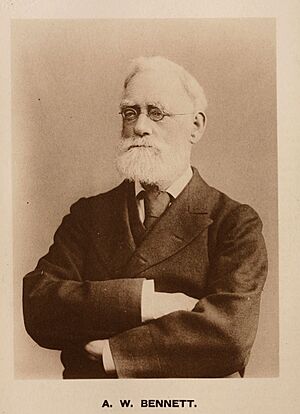Royal Microscopical Society facts for kids
 |
|
| Founded | September 1839, Royal Charter in 1866 |
|---|---|
| Type | Professional organisation and registered charity |
| Registration no. | 241990 |
| Purpose | to promote the advancement of microscopical science by such means as the discussion and publication of research into improvements in the construction and mode of application of microscopes and into those branches of science where microscopy is important. |
| Location |
|
| Origins | Microscopical Society of London |
|
Area served
|
UK, worldwide |
|
Members
|
1379 |
|
Key people
|
President Peter J O'Toole Vice President Grace Burke Vice President Rik Brydson Patrons: *Baroness Finlay of Llandaff *Baroness Brown of Cambridge |
|
Revenue
|
£1,639,504 (year ending Dec 2015 |
|
Employees
|
17 |
|
Volunteers
|
100 |
The Royal Microscopical Society (RMS) is a group of scientists and people who love microscopy. They work to make microscopes better and to help people learn more about tiny things. It started way back in 1839 as the Microscopical Society of London. This makes it the oldest group of its kind in the whole world!
In 1866, the Society received a special permission from the King or Queen, called a royal charter. That's when it changed its name to the Royal Microscopical Society. Even though it started with people who just enjoyed microscopes as a hobby, today its members are experts from all over the world.
Since 1841, the Society has published its own scientific journal called the Journal of Microscopy. This journal shares new discoveries and research about microscopes. The RMS is also a charity that helps science grow, supports careers in science, and teaches everyone about science and microscopy.
One of the Society's most important contributions was creating a standard size for microscope glass slides in 1840. These 3x1 inch slides are still the most common size used today. They are even known as the "RMS standard."
The Royal Microscopical Society works with other big science groups. These include the Foundation for Science and Technology, the European Microscopy Society, and the International Federation of Societies for Microscopy.
Contents
History of the RMS
The Royal Microscopical Society began on September 3, 1839. Seventeen gentlemen met to talk about starting a group to study tiny things. They wanted to make microscopes better and use them more in science. This meeting happened after many exciting new discoveries in microscopy.
At this first meeting, they decided to form a society. They called it the Microscopical Society of London. On December 20, 1839, a public meeting was held in London. Professor Richard Owen was chosen as the first president. He is famous for inventing the word "dinosaur." Forty-five men joined as members.
The Society bought the best microscopes available at the time. In 1866, the Society became the Royal Microscopical Society. This happened when they received their special Royal Charter.
In 1870, one of the presidents, Rev. Joseph Bancroft Reade, joked about the Society's name. He said he suggested adding "-al" to "Microscopical" so people wouldn't think the members themselves were tiny objects!
John Thomas Quekett, whose brother helped start the Society, was its secretary for many years.
Women in Microscopy
In 1885, a botanist and women's rights supporter named Marian Farquharson became the first female Fellow of the Society. At first, women were not allowed to attend meetings. Marian worked hard to change this. She asked other important science groups to let qualified women become full members and attend meetings. Eventually, her efforts helped women gain more rights in scientific societies.
In September 1989, the Royal Mail released special stamps to celebrate the Society's 150th birthday. One of the stamps showed a snowflake, which is the Society's logo.
In 2017, two important women from the House of Lords became patrons of the Society. They were Baroness Brown of Cambridge and Baroness Finlay of Llandaff.
Joining the RMS
People who join the RMS come from many different science backgrounds. They all share an interest in microscopes and studying tiny things.
After being a regular member for three years, members can become a Fellow of the Society. This means they meet certain requirements and can vote on Society matters. They can also use the letters FRMS after their names.
Honorary Fellows
The Society also has special members called Honorary Fellows. These are people who have made very important contributions to microscopy.
Leaders of the Society
The Society has a group of 23 Trustees who help guide it. These include Professor Maddy Parsons and Professor Michelle Peckham. The current President of the Society is Peter J. O'Toole.
Many famous scientists have been President of the Society since it started. These include Prince Philip, Duke of Edinburgh, who was President in 1966.
RMS Activities and Programs
The Royal Microscopical Society does a lot of activities to help people learn about science. They especially focus on getting children interested in science.
Microscope Activity Kits
One popular program is the Microscope Activity Kit Scheme. It started in March 2011. This free program sends Kits full of microscopes and fun activities to primary schools across the UK and Ireland. Schools can use a Kit for a whole term. By December 2014, over 20,000 children had used these Kits!
RMS Diploma
The RMS Diploma is a special qualification launched in 2012. It helps people who use microscopes improve their skills and advance their careers. To get the Diploma, candidates create their own study plan with help from their managers and other experts. This makes sure the learning is useful and fits with their job.
Courses and Conferences
Every year, the RMS holds many meetings, courses, and conferences. Some of these are even online! Their biggest event is the Microscience Microscopy Congress (mmc) Series, which happens every two years. These events are great for learning about the newest discoveries in science. They bring together scientists from many different fields, from studying crime scenes to looking at living cells.
Supporting Gender Equality
Since 2017, the RMS website has a list of women who work in microscopy. This helps people organizing conferences find more women speakers for their events. Scientists can add their own names to the list or suggest others.


